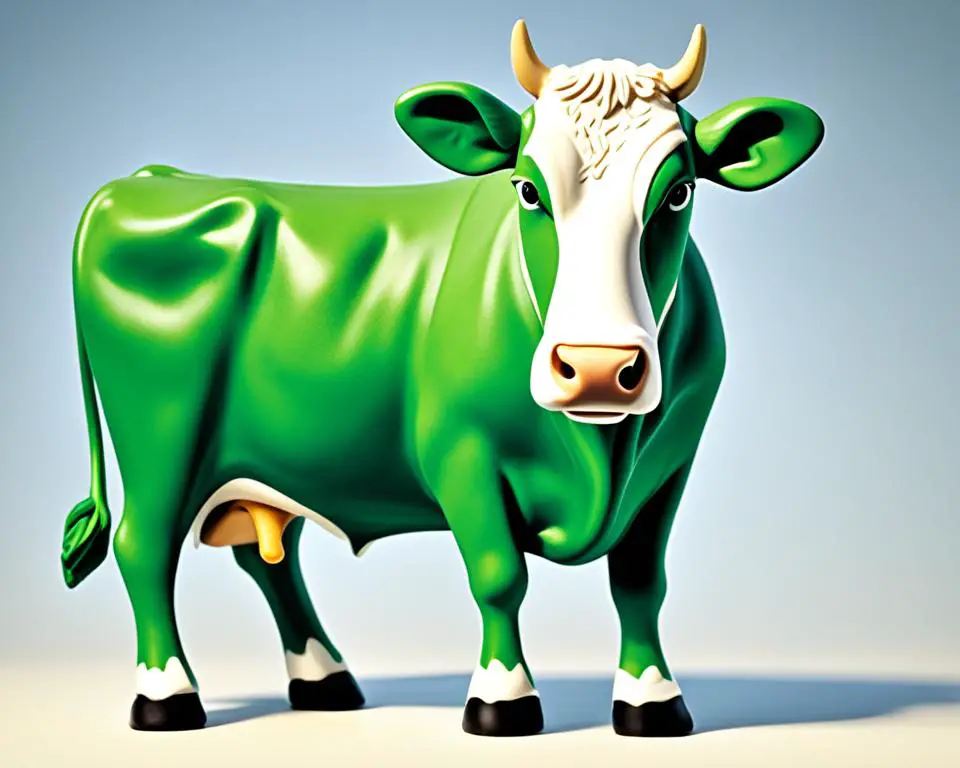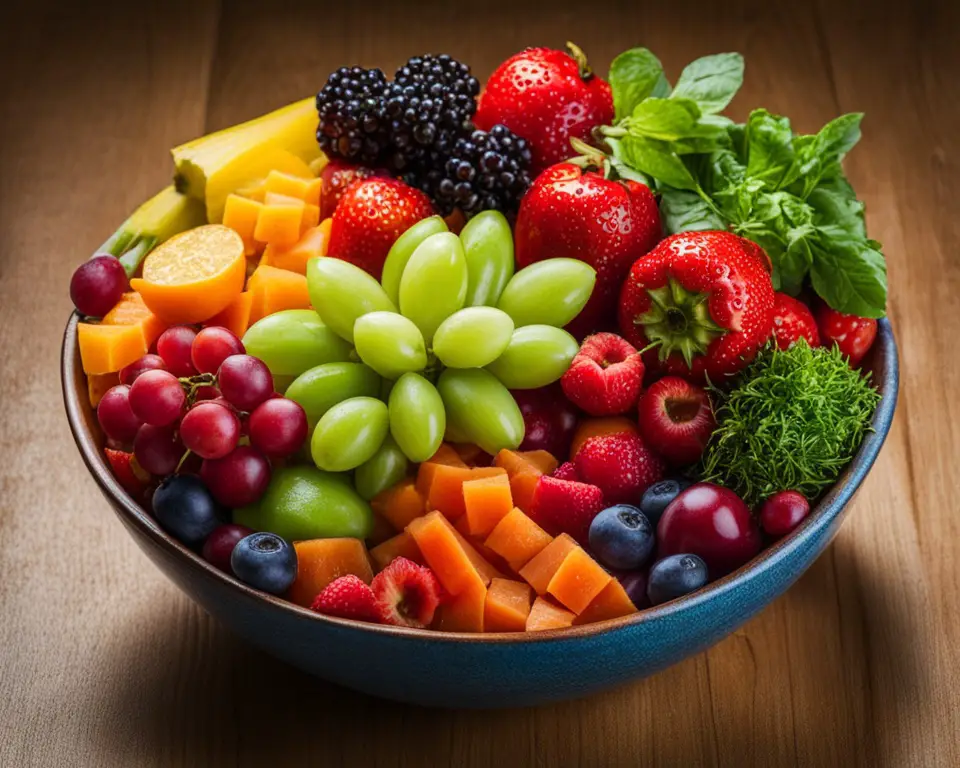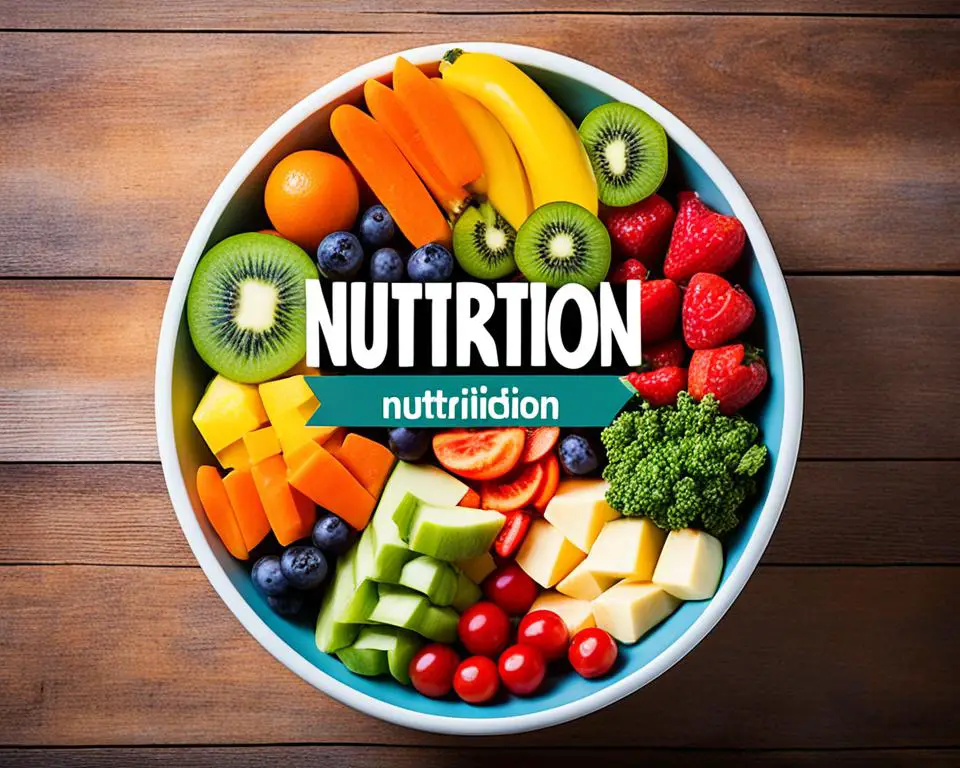Keeping a balanced diet is key for good health. By understanding calories, you can manage your food intake better. This leads to healthier eating habits. The American Heart Association suggests eating a variety of foods like vegetables, fruits, whole grains, and fish.
This approach helps you get the right amount of servings and control calories.
Many Americans get a third of their calories from eating out. It’s important to make smart food choices. Tools like the Food Calories Chart and products with the Heart-Check mark can help. Adding foods from brands like Eggland’s Best can also improve your diet.
Key Takeaways
- Balance your diet with recommended servings of various food groups.
- Utilize the Food Calories Chart for better dietary management.
- Consume nutrient-dense foods for healthy food choices.
- Incorporate whole foods and Heart-Check marked products.
- Make informed dietary decisions, even when dining out.
Understanding Food Calories
When exploring health and diet, grasping the calorie definition is key. A calorie is a unit of energy that tells us how much energy food gives us. Just like cars need gasoline, our bodies need calories to work, move, and stay alive. Knowing about calories helps us plan our diets better and get the most from our food.
What Are Calories?
Calories measure how much energy food has. They’re vital for our daily life, powering everything from digestion to exercise. For example, a single serving of frozen lasagna has 280 calories. If you eat the whole package, it gives you 1,120 calories, a big energy boost.
Why Calories Matter
Calories are more than just a way to measure energy. They’re crucial for planning diets and staying healthy. Knowing the nutritional value of food helps us make better choices. Food labels show the daily values for nutrients, helping us see if a food is good or bad for us.
For instance, a lasagna label might show it has a lot of bad fats and sodium but is full of good fiber and vitamins. This tells us to pick foods wisely to stay healthy. So, it’s not just how many calories we eat, but what kind of calories that matters.
The Healthy Eating Plate: A Balanced Diet Guide
Keeping a balanced diet is key for good health. The Healthy Eating Plate is a simple way to do this. It was made by nutrition experts at Harvard. It shows how important it is to eat different foods and control your portions.
Building a Healthy Plate
The Healthy Eating Plate says half your plate should be vegetables and fruits. This follows guidelines that highlight these food groups. Try to eat at least 5 different fruits and vegetables every day. You can use fresh, frozen, tinned, dried, or juiced versions.
Starchy foods should take up about a third of your plate. Include foods high in fiber or wholegrain. Eating at least 2 portions of fish a week is good for you. Include oily fish in one of those portions. Milk, cheese, yogurt, and fromage frais are great for protein and calcium, which are good for your bones.
Use unsaturated fats like vegetable, rapeseed, olive, and sunflower oils in small amounts. They are healthier choices. But, eat foods high in fat, salt, and sugar less to stay healthy.
Portion Sizes and Caloric Intake
Controlling how much you eat is important. Women should aim for about 2,000 calories a day, and men should aim for 2,500. The Eatwell Guide suggests adjusting your diet based on your needs.
Here are some guidelines for portion sizes to help you eat balanced meals:
| Food Group | Recommended Servings |
|---|---|
| Fruits | At least 2 servings per day |
| Vegetables | At least 3 servings per day |
| Grains | Between 3 to 8 bowls per day |
| Meat, Fish, Eggs, and Alternatives | 5 to 8 taels daily (1 tael ≈ 40 grams of raw meat) |
| Milk and Alternatives | At least 1 to 2 servings per day |
| Fluid Intake | 6 to 8 glasses per day |
These guidelines help you make balanced meals. They ensure you get all the nutrients you need for good health. By controlling your portions and eating a variety of foods, you can manage your calories and live a healthy life.
Calories in Common Foods
Knowing the calories in everyday foods is key for good meal planning and nutritional choices. This guide looks at the calories in fruits, vegetables, proteins, and grains. It aims to help you make better nutritional decisions.
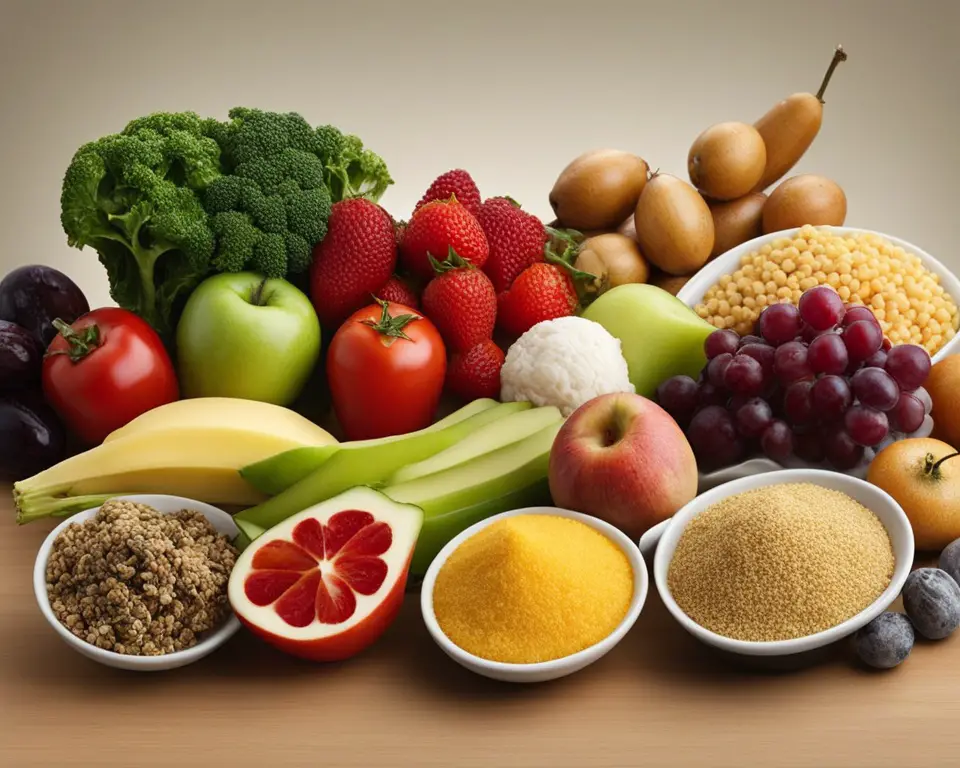
Fruits and Vegetables
Fruits and vegetables are low in calories but high in nutrients. Let’s see their calorie counts:
| Food Item | Calories |
|---|---|
| Banana (medium) | 105 calories |
| Watermelon (per 100g) | 24 calories |
| Strawberries (5 medium) | 16 calories |
| Potato (medium, with skin) | 93 calories |
| Broccoli (per cup) | 28 calories |
| Sweet potato (medium, with skin) | 298 calories |
Proteins
Proteins are important for fixing and building muscles. Here are some common protein sources and their calories:
| Food Item | Calories |
|---|---|
| Chicken breast (no skin, per 100g) | 164 calories |
| Beef mince (lean, per 100g) | 170 calories |
| Egg (large, scrambled) | 102 calories |
| Tuna (in springwater, per small can) | 82 calories |
Grains
Grains are a big part of many diets, giving us carbs for energy. Let’s compare some grains for better nutritional choices:
| Food Item | Calories |
|---|---|
| Brown rice (1/2 cup cooked) | 128 calories |
| White rice (1/2 cup boiled) | 134 calories |
| Quinoa (1/2 cup cooked) | 96 calories |
| Bread (white, per slice) | 91 calories |
| Multigrain bread (per slice) | 93 calories |
| Sourdough bread (per slice) | 93 calories |
| Pasta (1/2 cup cooked) | 95 calories |
Knowing the calories in these common foods helps you make better meal plans and choices for your health.
Using a Food Calories Chart for Smart Eating
A food calories chart is a great tool for better diet planning and making wise food choices. It helps with calorie tracking and portion control. Knowing the calories in different foods can help you reach your diet goals.
For example, if you want to eat less to lose weight, adding foods like artichoke (18 kcal per 100g) and cottage cheese (103 kcal per 100g) can help. On the other hand, foods high in calories like butter (744 kcal per 100g) and coconut oil (899 kcal per 100g) should be eaten in small amounts. This keeps your calorie intake at 1,500 calories a day.
![]()
A food calories chart is also great for managing portions. For instance:
| Category | Item | Calories (per 100g) |
|---|---|---|
| Dairy and Eggs | Butter | 744 kcal |
| Dairy and Eggs | Cheddar Cheese | 416 kcal |
| Dairy and Eggs | Cottage Cheese (1%) | 103 kcal |
| Fish | Salmon | 230 kcal |
| Fish | Mackerel | 233 kcal |
| Fish | Herring | 200 kcal |
| Vegetables | Acorn Squash | 40 kcal |
| Vegetables | Artichoke | 18 kcal |
For better diet optimization, add high-protein and high-fiber foods to your meals. Lentils have 96 kcal per 100g and are full of protein and fiber. They’re perfect for a balanced diet.
Tracking calories helps stick to a 1,500-calorie diet, which is good for losing weight. Cutting 500 calories a day can lead to losing 1 pound a week. This is a healthy and steady way to reach your weight goals. Using a food calories chart makes it easier to control portions and stay on track with your diet.
Calculating Your Daily Caloric Needs
Knowing how many calories you need every day is key to a balanced diet and reaching your health goals. A daily calorie calculator helps figure out your calorie needs based on your energy level, age, sex, and how active you are.
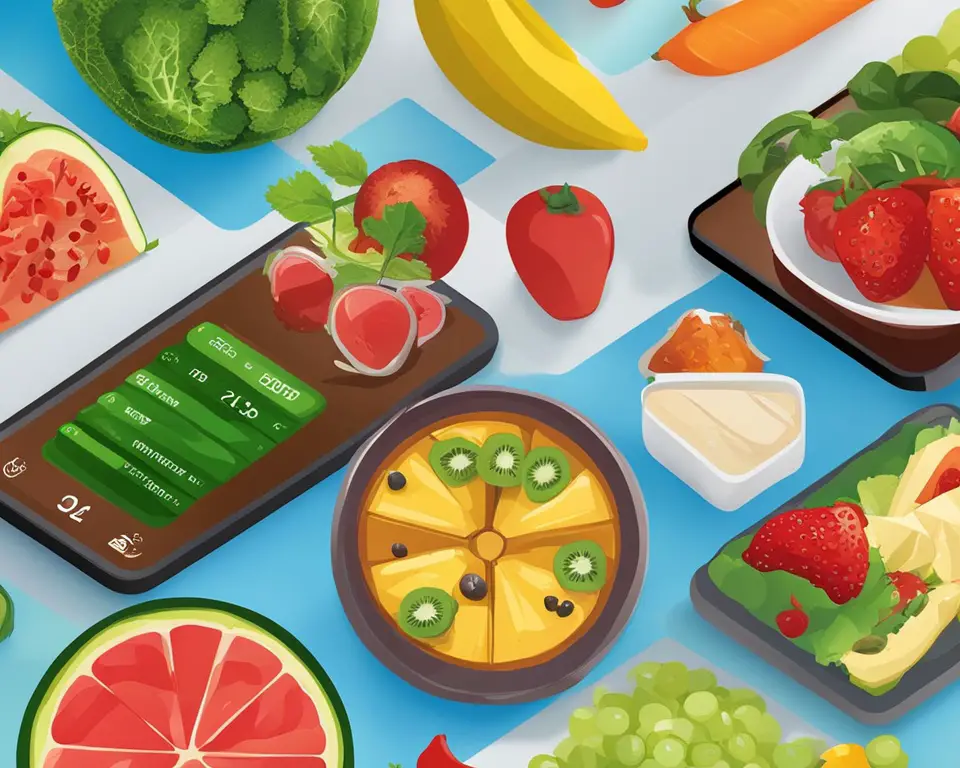
Personalized Plans
Getting a diet plan that fits you means your calorie goals match your unique needs. Women usually need at least 1,600 calories a day to stay at a healthy weight. Men need about 2,000 calories. The MyPlate Plan is a great tool to set your calorie intake right. If you’re not very active, you might only need 1,600 calories a day. But if you’re very active, you’ll need more.
Age, Sex, and Activity Levels
Your calorie needs depend on your age, sex, and how much you move. For instance, women between 19 and 30 should aim for 2,000 to 2,400 calories a day. Those 31 to 60 might need 1,600 to 2,200 calories. Men in the same age groups should look to consume 2,400 to 3,000 calories daily, or 2,200 to 3,000 if older.
It’s important to think about your BMI and other personal details too. For more info on setting your calorie goals, check out this calories chart or this guide on how to figure out your calorie.
As we get older, our metabolism slows down. Adult women usually burn about 1,400 to 1,500 calories a day. Adult men burn 1,600 to 1,800 calories. Adjusting your diet to these changes helps you stay healthy for the long run.
Healthy Protein Sources
Adding lean proteins to your meals is key for a balanced diet and heart health. You can choose from animal or plant-based options. It’s important to know the benefits and protein levels in each to make the best choices for your diet.
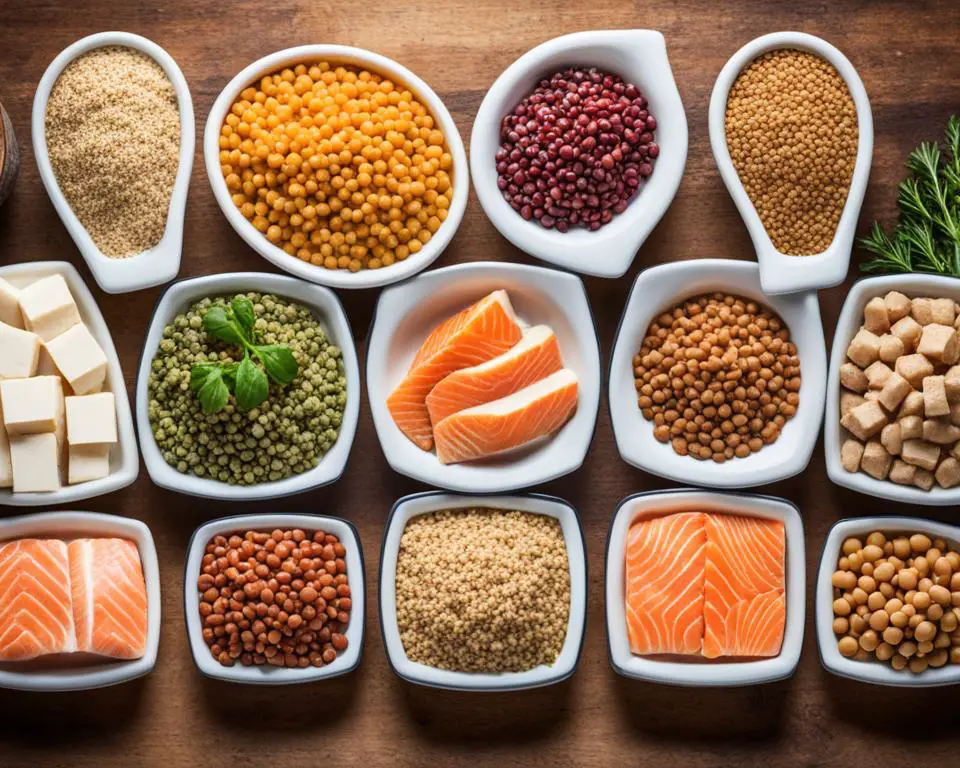
| Food | Serving Size | Protein (g) |
|---|---|---|
| Greek yogurt, 2% low-fat plain | 6 oz | 17 |
| Eggs | 1 large egg | 6 |
| Lean beef (round) | 3 oz | 24.9 |
| Skinless turkey breast | 4 oz | 34 |
| Black beans | 1/2 cup | 7.5 |
| Salmon | 4 oz | 18.8 |
| Almonds, dry roasted | 1 oz | 6.3 |
| Chickpeas (Garbanzo), canned | 1/2 cup | 6 |
| Chicken breast, skinless, cooked | 3 oz | 18 |
| Pumpkin seeds | 1 oz | 12 |
| Shrimp | 1 oz | 5.9 |
| Cashews, dry roasted | 1 oz | 4.3 |
| Cottage Cheese, 2% fat | 1 oz | 4 |
| Lentils | 1/2 cup | 9 |
| Atlantic Salmon, baked | 4 oz | 18.8 |
For a heart-healthy diet, eat less red meat and processed meats. Choose leaner proteins like fish, poultry, and plants instead. These choices are good for your health and the planet. Adding these proteins to your meals makes your diet both healthy and eco-friendly.
Choosing Whole Grains
Whole grains are key to a healthy diet, offering many benefits for your well-being. Eating whole-wheat bread, whole-grain pasta, and brown rice can make a big difference in your health. Let’s look at the benefits and examples of whole grains to help you choose better.
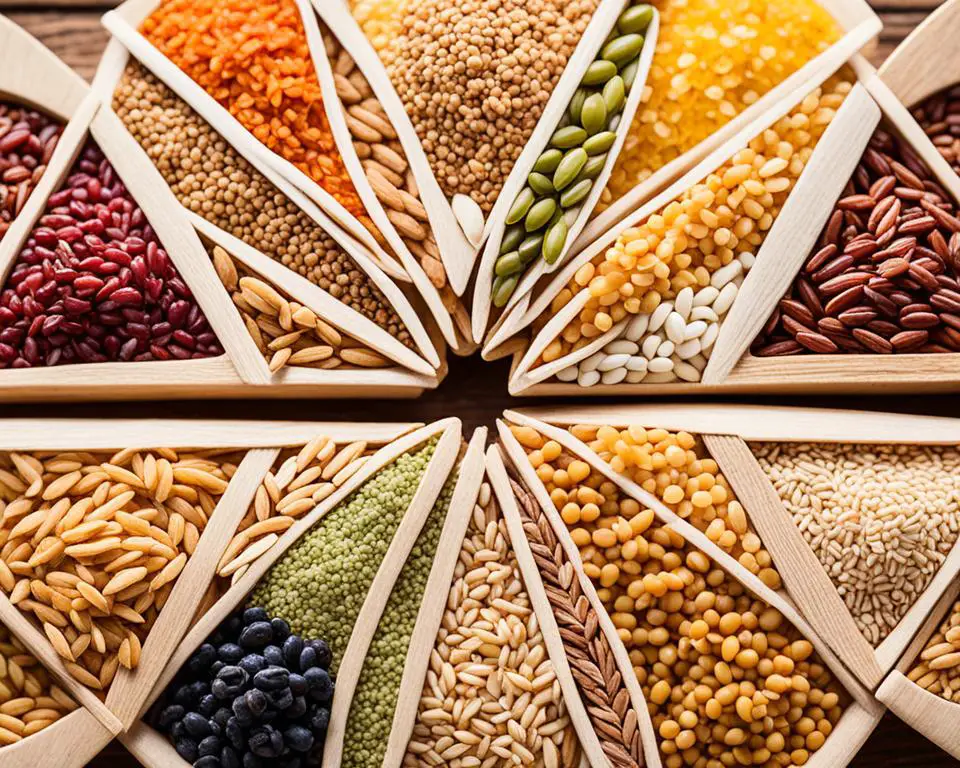
Benefits of Whole Grains
Whole grains are packed with nutrients our bodies need. They are full of dietary fiber, which helps with digestion and keeping a healthy weight. Foods high in complex carbohydrates from whole grains give you steady energy, making them great for meals and snacks.
Whole grains also help manage blood sugar levels. Choosing whole grains over refined ones can prevent blood sugar spikes, which is good for diabetes management. They are also linked to a lower risk of heart disease, making them a smart choice for daily meals.
Examples of Whole Grains
Here are some great whole grains to add to your diet:
- Barley: Great in soups, stews, and salads.
- Quinoa: High in protein and versatile in recipes.
- Brown Rice: Keeps its nutrient-rich bran and germ layers.
- Whole-Wheat Bread: Has more nutrients than white bread.
- Whole-Grain Pasta: A fiber-rich alternative to regular pasta.
Try to eat at least half of your grains as whole grains. This ensures you get enough fiber and complex carbohydrates. These nutrients help keep your energy up and support your health. Switch to more unrefined grains for a healthier life.
The Impact of Sugary Drinks
Sugary drinks add a lot of calories to our daily diet. In 2011-2014, 63% of kids and 49% of adults had a sugary drink on any given day. Kids got about 143 calories from these drinks, and adults got 145 calories.
Not everyone drinks sugary beverages the same amount. Boys, teens, non-Hispanic Black youth, and those from low-income families drink more. Males, young adults, non-Hispanic Black or Mexican American adults, and those with lower incomes also drink more. Knowing this helps us focus on who needs help the most.
Where you live affects how much sugary drinks you drink. The most drinks were consumed in the Northeast and South. Sugary drinks give a lot of calories and added sugars, making up a big part of what Americans eat.
Research shows a lot of these calories come from drinks at home and some from outside. This is worrying. The Harvard T.H. Chan School of Public Health has looked into this deeply.
Sugary drinks are bad for our health. They are the biggest source of added sugars in our diet. Since 1942, studies have shown they can lead to weight gain and increase the risk of type 2 diabetes.
Drinking water, tea, and coffee instead can help reduce calories and improve health. For more info on sugar and its effects, check out the CDC’s detailed data.
Source Links
- Suggested Servings from Each Food Group
- Printable Materials and Handouts | Nutrition.gov
- Setting the Table for Healthy Eating
- How to Understand and Use the Nutrition Facts Label
- Calories for Thousands of Foods: Your Calorie Chart Database
- Food Calories Chart | What’s In Your Fruit, Veg, Meat, And Other Daily Produce? – MYPROTEIN™
- The Eatwell Guide
- MyPlate Healthy Eating Chart Replaced the Food Pyramid
- Centre for Health Protection, Department of Health – The Food Pyramid – A Guide to a Balanced Diet
- The ultimate list of calories in all your favourite foods
- 45 Common Foods and the Number of Calories They Contain
- Calories per 100 grams of food
- Food Calories Chart | What’s In Your Fruit, Veg, Meat And Other Daily Produce? | MYPROTEIN™
- A 1,500-Calorie Diet: Food Lists, Meal Plan and More
- 7-Day Heart-Healthy Meal Plan Created by a Dietitian: 1,200 Calories
- How Many Calories Should You Eat per Day to Lose Weight?
- How Many Calories Do You Really Need?
- Nutrition: Determine Your Calorie Count – familydoctor.org
- High protein foods chart [with printable PDF]
- Printable List of 60 High Protein Foods (FREE Download)
- Healthy Eating Plate
- USDA MyPlate Grains Group – One of the Five Food Groups
- Healthy Eating As You Age: Know Your Food Groups
- Sugar Sweetened Beverage Intake
- Effects of Soft Drink Consumption on Nutrition and Health: A Systematic Review and Meta-Analysis
- Sugary Drinks

